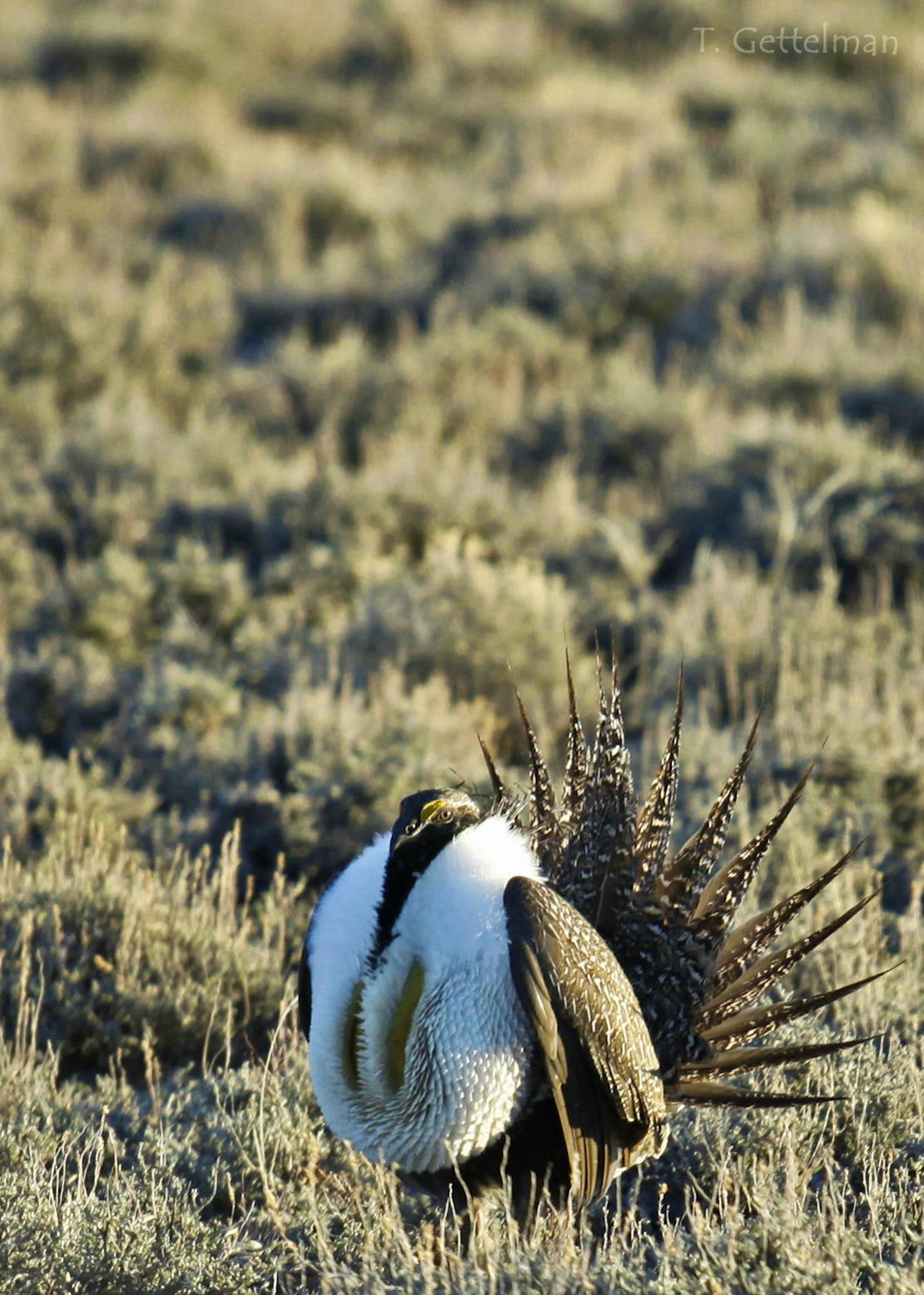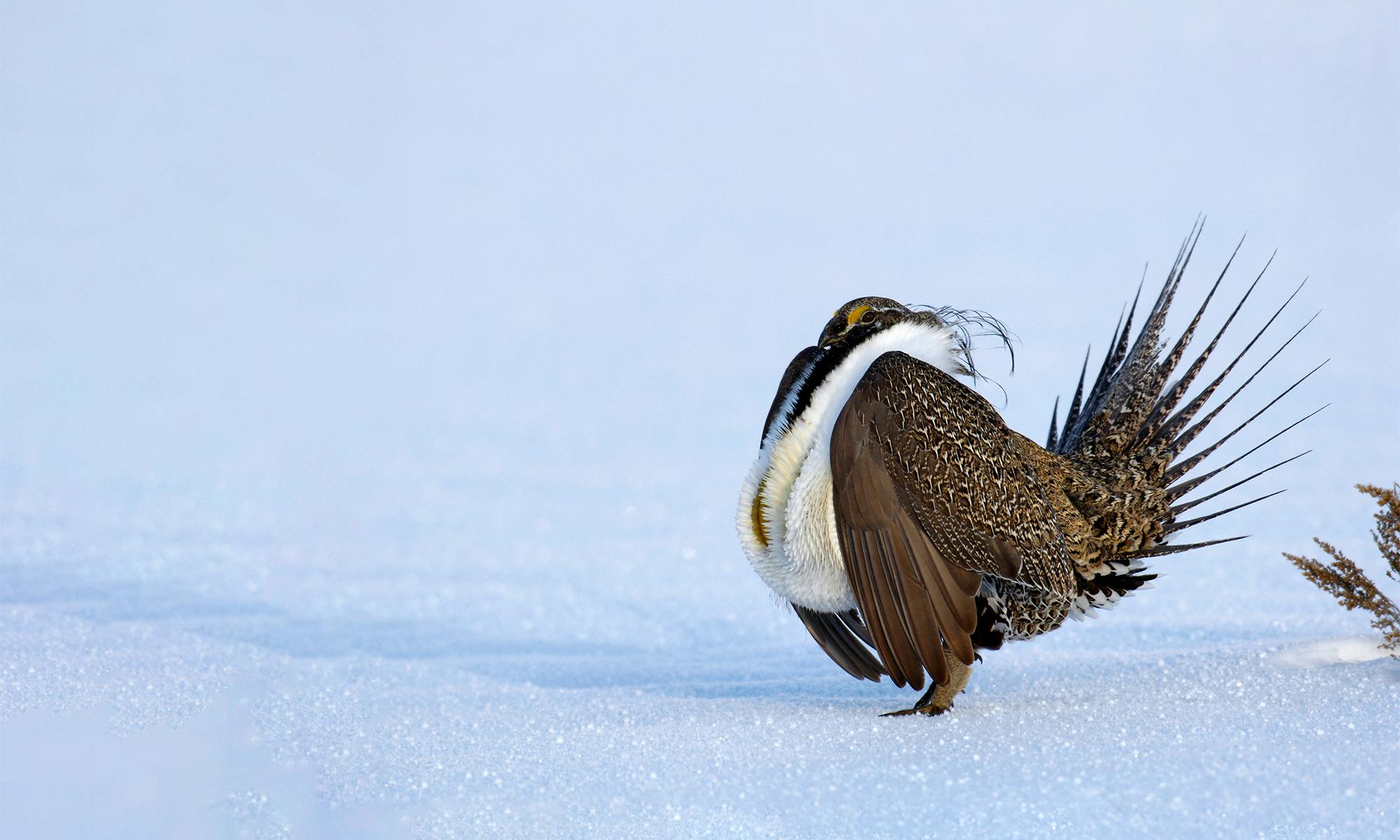Join our mobile Rapid Response Network!
You can be the first to hear about how we’re going to hold this administration accountable and how you can fight back for wildlife!
Greater sage-grouse and Gunnison sage-grouse are closely related species. They live in the Sagebrush Sea, an ecoregion that blankets much of the interior west and supports hundreds of species of at-risk plants and animals.
Sage-grouse need large expanses of healthy sagebrush grasslands and functioning hydrologic systems to survive and flourish. Conserving sage-grouse benefits a host of other species in the Sagebrush Sea, including pronghorn, elk, mule deer, native trout, pygmy rabbit, and nearly 200 migratory and resident bird species.
Why are sage-grouse imperiled?
Both the Gunnison sage-grouse and the greater sage-grouse are trending toward extinction.
Currently, there are likely 4,000 or less Gunnison sage-grouse left. They are facing a very uncertain future in western Colorado and southeastern Utah where development (energy and residential) and climate change are altering habitat.
While the greater sage-grouse still occur across much of the northern interior west, its populations continue to decline. A recent US Geological Survey study found that the Greater sage-grouse has declined 80% range wide since 1965 and nearly 40% since 2002 and the downward trend is forecast to continue absent stronger conservation.
More than half of the Sagebrush Sea natural habitats have been lost to development and agriculture. Currently, we continue to lose on average over one million acres of sage-grouse habitat each year to a combination of fires, invasive species, drought, energy development, mining, transmission and roads.
Habitat loss and fragmentation, climate change, invasive species, energy development, unnatural fire and livestock grazing.
greater sage-grouse
Gunnison sage-grouse
greater sage-grouse
Gunnison sage-grouse

Defenders' Impact
Defenders is working to ensure that federal agencies and western states implement conservation measures to restore these magnificent birds and the Sagebrush Sea ecosystems on which they depend.
In 2015, the federal government culminated an unprecedented multi-stakeholder planning process to develop a greater sage-grouse conservation strategy covering almost 70 million acres of federal public lands in the West. Defenders participated in the process to develop this strategy, even as we remained concerned that it might not be adequate to assure recovery. The strategy barely had time to work before the first Trump administration weakened it, eliminating key protections.
In 2022, the Bureau of Land Management – the entity responsible for the largest portion of sage-grouse habitat (70 million acres) -- started another iteration of evaluating the plans to account for updated science, especially around climate change impacts and improved methods for monitoring populations. Defenders participated in this process as well. Defenders developed and formally submitted a range wide proposal to conserve a network of “Areas of Critical Environmental Concern.” The proposal was designed to capture the lands deemed essential for the long-term viability of the bird.
In January 2025, the agency finalized new plans for the greater sage-grouse in Colorado and Oregon but failed to complete revisions for the other eight states. In our estimation, the conservation plans for Colorado and Oregon provided weaker safeguards for the sage-grouse than the original 2015 greater sage-grouse conservation strategy and omitted critical protections such as the Area of Critical Environmental Concern (ACEC) designations for which Defenders advocated.
As we approach 2026, the greater sage-grouse still wants for strong conservation protections that will keep it from becoming endangered. The second Trump Administration is once again trying to weaken existing conservation protections. In September 2025, the Bureau of Land Management proposed rolling back safeguards protecting the species and their mating grounds from damaging activities including mining, oil and gas drilling, excessive grazing, and transmission lines. Defenders is continuing to advocate for science-based conservation protections for the sage-grouse across its entire range.
What You Can Do
Hold federal agencies, states and local jurisdictions accountable for conserving sage-grouse species through land protections and conservation measures designed to address threats. Remove fences and mark remaining fences with highly visible flags to help prevent sage-grouse from colliding with them. Manage your land through conservation easements.

About
Greater sage-grouse are a widely distributed but sparsely populated species that occur in Oregon, Idaho, Nevada, Montana, Wyoming, Utah and Colorado, with remnant populations in Washington, California, North Dakota, South Dakota, Alberta and Saskatchewan. Gunnison sage-grouse range is limited to southwestern Colorado and southeastern Utah.
The total population of greater sage-grouse is estimated around 200,000, while there are less than 4,000 Gunnison sage-grouse remaining.
Sage-grouse use different seasonal habitats over the during the course of the year, with some populations moving up to 100 miles between spring, summer, autumn and winter habitat areas.
The sage-grouse mating ritual is fascinating to observe and often described as among the most stirring and colorful natural history pageants in the West. In early spring, at dawn and often at dusk, sage-grouse congregate on "leks"—ancestral strutting grounds to which the birds return year after year. Leks vary in size from one to 40 acres and may be up to 50 miles from the birds’ winter habitat. To attract a hen, cocks strut, fan their tail feathers and swell their breasts to reveal yellow air sacs. The combination of wing movements and inflating and deflating air sacs make an utterly unique "swish-swish-coo-oopoink!"
Sage-grouse feed on wildflowers and insects in spring and summer. They depend on sagebrush for food year-round, especially in winter when sagebrush is the only available food source.
Featured
Sage-Grouse Action Center
Learn about current initiatives for Greater sage-grouse and Gunnison sage-grouse and how to get involved.
Publications
Read More About the Sage-Grouse
News










